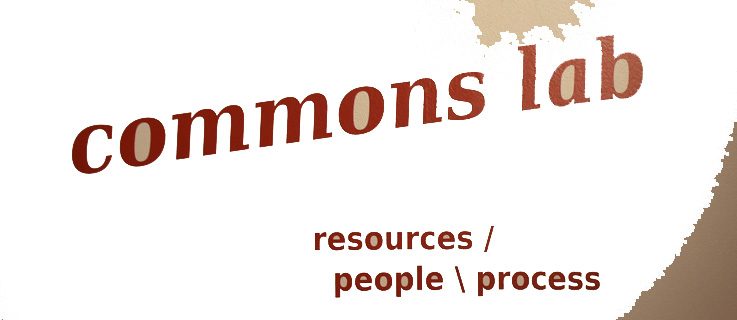The German artist Cornelia Sollfrank landed on Canadian soil for the first time this spring. As an art researcher, activist and hacker, she made a name for herself in the net art scene of the late 1990’s and early 2000’s before obtaining a Ph.D. from the University of Dundee in Scotland with a thesis about copyright and art. Through April 22, 2017, the art centre Studio XX shows commons lab, an exhibit curated by Erandy Vergara, with accompanying public events at Concordia University and McGill University and a two-part workshop series.
“HOW ARE WE TOGETHER TODAY IN ART?”
MAGDA TYŹLIK-CARVER
After her studies at the Munich Art Academy and the University of Fine Arts in Hamburg, Germany, Cornelia Sollfrank headed for a career in conceptual media art. In 1997 she co-founded
Old Boys Network, a cyberfeminist international collective that includes mailing lists and a website and serves as a platform for discussions about cyberfeminist theories and practices. In 2006, Sollfrank, together with other artists, launched THE THING, an online platform for art and art critique, in Hamburg, Germany, modeled after the New Yorker artist network THE THING founded by Wolfgang Staehle in 1992. Building on the idea of the
Old Boys Network, this independent net-based infrastructure has allowed Sollfrank to experiment with different organisational forms and comprehend them as artistic formations (see link # 1 at the right of page).
I talked to Cornelia Sollfrank on April 2 this year – about topics related to her research and, naturally, also about exhibitions of her work. Today Sollfrank is being invited to interventions and performances on the Internet and in brick-and-mortar locations. She never imagined that her works would be displayed at a gallery, in a static white cube, that sacred space dedicated to the veneration of artists. c
ommons lab mirrors Sollfrank’s philosophy in all areas of life, and propagates the value of sharing and the communality of goods. Her approach is based on the three elements of commons, as described by Massimo de Angelis. He defined commons not only as the resources shared by the community but also as the bundled resources, the communities themselves, and the communality of goods. In that spirit Sollfrank promotes knowledge-sharing, encourages freely accessible open-source software, freely available licences, and, going one step farther, do-it-yourself technologies and online libraries free of charge, with Wikipedia as a successful example. Sollfrank also refers to the American economist Elinor Ostrom, the first woman to receive the Nobel Prize in Economics in 2009 for her identification of the eight design principles of common-pool resources in stable communities (see link # 2).
The space that Sollfrank’s work occupies in Studio XX bears resemblance with the solo exhibitions in the late 18th and early 19th centuries. They sprang from individual initiatives, the desire to display a critical point of view that often diverged from the mainstream opinion. Many of the exhibitions were held only because the official art institutions, which in that era were the exclusive validators of artists, had rejected them. In his article about the origin of solo exhibits, the American curator João Ribas emphasises that these events were a protest against the official system in England and France. In his view, contemporary art history is not giving enough attention to those solo exhibits, and part of the reason for this absence is a market-driven focus of the art world, which leads to the circulation of speculative value and a legitimisation that generates distinction for the artists and puffs up their significance. In our time, solo exhibitions are an industry encompassing collectors, galleries and art dealers, art critics, museums, non-for-profit organisations, art fairs and biennales. It seems that such exhibitions have lost their initially dissident and polemic-provoking character, and they are now being perceived as a canonical form lacking in criticality. Ribas closes his article by questioning the function of solo exhibitions, „(…) how might we call upon the errant history of resistance, experimentation, negation and critical engagement that the solo exhibition has represented to reflect upon the current role of such exhibitions within a globalised art system?“ (from: João Ribas. Notes Towards a History of the Solo Exhibition.)
commons lab tries to answer that question. Cornelia Sollfrank invites us to a critical sphere, one that is open for new organisational forms outside the mainstream currents and offering more freedom and diversity. Studio XX is the suitable venue for this undertaking. Founded with an alternative mission, it is a democratic, integrative forum, dedicated to feminism and sensitive to gender issues. It is a place that has adopted a policy of non-oppression, a centre with a decentralised organisation.
On a larger scale,
L’Internationale, an association of six museums at different locations in Europe, is also pursuing the commons theme. Setting aside concerns about competition, intellectual property and ownership, the museums, in an atmosphere of mutual trust, search for new forms of collaboration. The Spanish art historian Manuel Borja-Villel summarises the mission of this alliance as follows, „Between the globalised world of the market and a society ruled by an administrative regime, we have to find a space of resistance, a space in common." (Nathalie Zonnenberg. Ibid. p. 64., see link # 3).
In this spirit, the
commons lab at Studio XX was conceived outside the art market, art speculations and art world hierarchies. It takes the shape of a dynamic space, underscored with documentation by engaged authors who have influenced Sollfrank, and by short essays by the artist herself. The words are displayed on a variety of materials, ranging from texts on banners to keywords and quotes on cardboard that the visitors can move around as they wish. Together with the German graphic designer Janine Sack, Sollfrank has developed the design concept for the space which also includes an open source font. The dominant colour is red, yet it is broken up by a wide palette of grey shades. Red is a highly political colour, for which Sollfrank took her cues from the Russian avant-garde. However, she says she did not want to refer directly to that era; it was a different time with an entirely different historical context. All the more it is important for the artist that the space feels warm and inviting and the visitors feel comfortable and at ease.
-
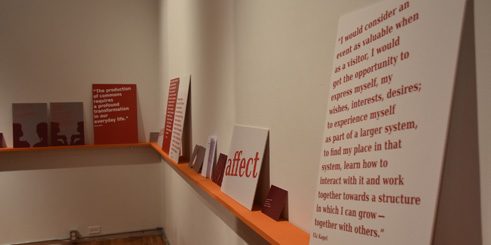 © Martine Frossard
© Martine Frossard
Commons Lab
-
 © Martine Frossard
© Martine Frossard
Commons Lab 2
-
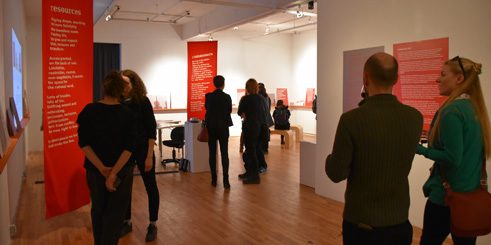 © Martine Frossard
© Martine Frossard
Commons Lab 3
-
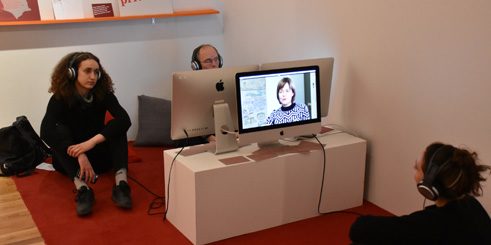 © Martine Frossard
© Martine Frossard
Commons Lab 4
-
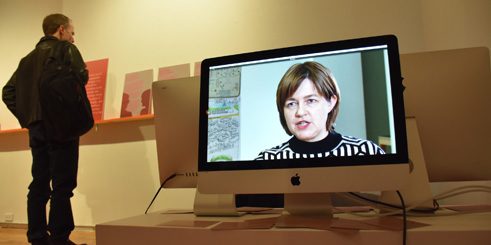 © Martine Frossard
© Martine Frossard
Commons Lab 5
-
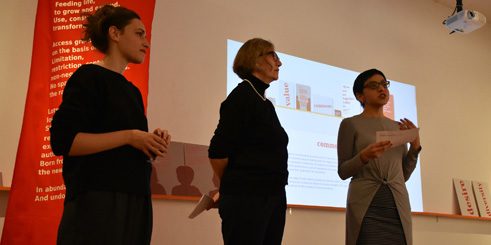 © Martine Frossard
© Martine Frossard
Commons Lab 6
-
 © Martine Frossard
© Martine Frossard
Commons Lab 7
-
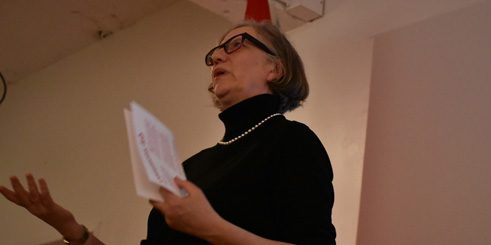 © Martine Frossard
© Martine Frossard
Commons Lab 8
-
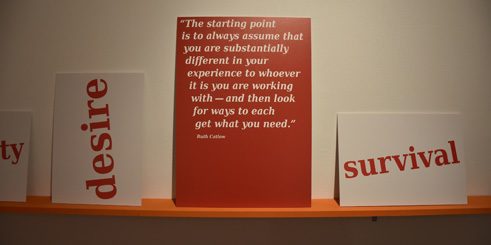 © Martine Frossard
© Martine Frossard
Commons Lab 9
-
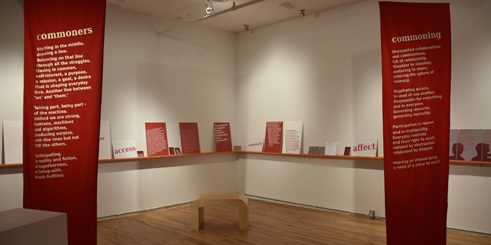 © Martine Frossard
© Martine Frossard
Commons Lab 10
The act of sharing, a central concept of the exhibition and the leitmotif of Cornelia Sollfrank, is also reflected in the setting. One area with tables, chairs and benches is used for teamwork and meetings while another area with a rug and floor cushions invites visitors to relax. This is also where videos of three encounters of the artist with international curators are shown. Magda Tyźlik-Carver (England), Ela Kagel (Germany) and Ruth Catlow (England) spoke with Sollfrank about their experiences managing cultural institutions.
commons lab is an experimental environment, a functional structure, and the opposite of a space for mere contemplation. The exhibit space has been designed as a modular, freely expandable system open for improvisations, which facilitates discussions, dialogues and processes – all things that are currently happening. It is no longer the artist or author who determines what happens in that space, instead, they make room for shared projects. It is a hybrid space, a mix of research centre, hacker space and loft were a creative team pulls an all-nighter to meet a deadline. In the
commons lab at Studio XX it is the action that resonates, the desire to accomplish something as a group. Awareness that art plays a big role is important, Sollfrank points out. She also acknowledges that is not easy to create a setting where people truly contribute something. It is a process that consumes a lot of time. At Studio XX she did not want to show a finished art installation nor did she want to start with an empty room but she wanted the room to change over time. The type of exhibition venue is important, too. An artist centre offers a great deal of flexibility for this type of project. As the exhibiting artist Sollfrank appreciates the trust that was placed in her, for example, she was given the keys to the venue, which would be unthinkable at a museum.
The workshops held in parallel to the exhibit also inspire to take action. Under the title
The Surplus of Sharing Books: Building a Feminist Libary Online they invite participants to compile a list of digitalised titles and make them available on the Internet. This circulates knowledge and makes it possible to create a collective memory to preserve it for future generations. There is a vast repertoire online of non-conventional resources such as experimental book formats, fanzines, self-published books by independent authors and works with small print runs. The
Shadow Library online, which is more or less a pirate library, circulates book titles outside the realm of the market-dominating large publishing houses.
UbuWeb, founded by the artist and author Kenneth Goldsmith, is the largest archive of its kind.
Memory of the world is a pirate library with currently more than 6,000 titles (see link # 4). Its founder, the Croatian Internet activist and researcher Marcell Mars, who maintains the library together with a group of collaborators, has even developed a scanner for the digitalisation of the books.
-
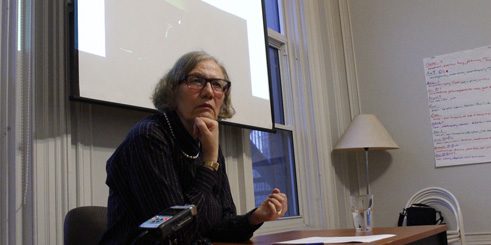 © Studio XX
© Studio XX
Cornelia Sollfrank
-
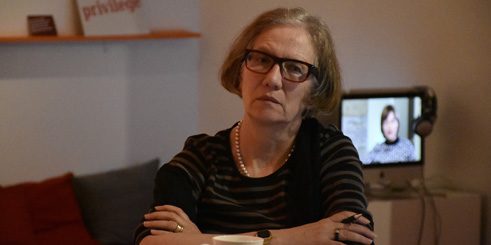 © Studio XX
© Studio XX
Cornelia Sollfrank
-
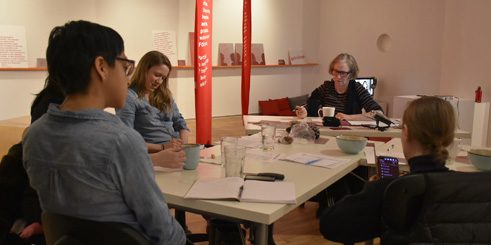 © Studio XX
© Studio XX
Workshop with Cornelia Sollfrank
-
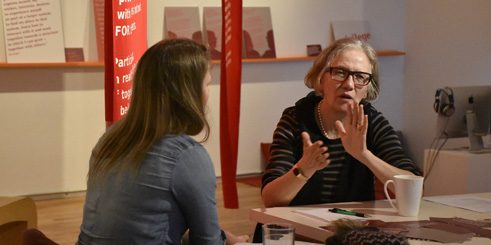 © Studio XX
© Studio XX
Workshop with Cornelia Sollfrank
-
 © Studio XX
© Studio XX
Workshop with Cornelia Sollfrank
-
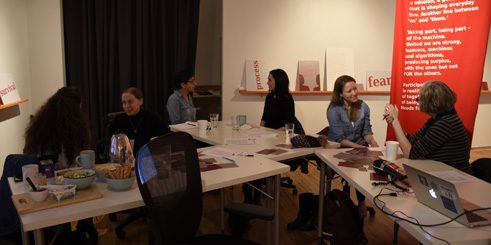 © Studio XX
© Studio XX
Workshop at Studio XX
The philosophy and organisation of the
commons lab, this space for participation, collaboration and common creativity at an art venue, differs on many levels from the concept that the French art theorist Nicolas Bourriaud pursued in his „Relational Aesthetics“ and in his work as a curator. Sollfrank is ambivalent about relational aesthetics, considering the lack of self-assessment. This approach does not explore how experiences are made by daring to ask difficult questions, which, through the critique of our institutions, make us think about our life. This involves questions such as, “What happened?”, “What are the consequences?” “Who is the audience?” “What are the goals?”
Since signing the
Cyberfeminist Manifesto, Sollfrank has learned to set limits for herself. The legacy is not directly feminist but offers a political understanding of where liberal thinking begins and where it ends. The commons lab and the concept of communality of goods are a platform that does not include everybody yet they are open for all those who believe in democratic values and are ready for negotiations and discussions. It is easy to declare, Sollfrank says, that you are a liberal and pro integration, it is however more difficult to defend certain values, draw lines and defend a system that’s under attack. For example, we cannot change a flaw of our time such as competitive thinking, and prevent it from being ubiquitous. c
ommons lab however sheds some light on it and hands us the resources to better understand the concept.
Commons lab is an example of a critical approach in art that is not often found in art institutions. It is not just an exhibition. Sollfrank challenges us to remain alert about the world we live in. The question arises how the real public space influences the online world, and vice versa. The artist pulls us out of our comfort zone and wants us to clear a path for ourselves so that we can find a better way to deal with the difficulties that surround us.
commons lab is part of “Germany@Canada 2017 - Partners from Immigration to Innovation”.
